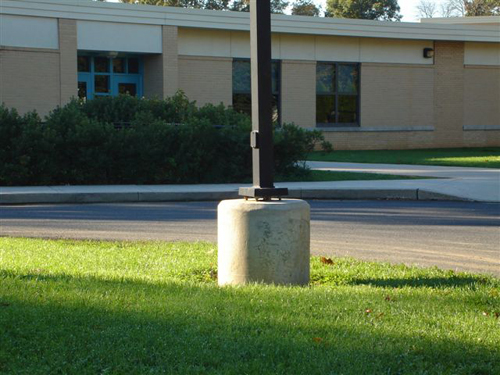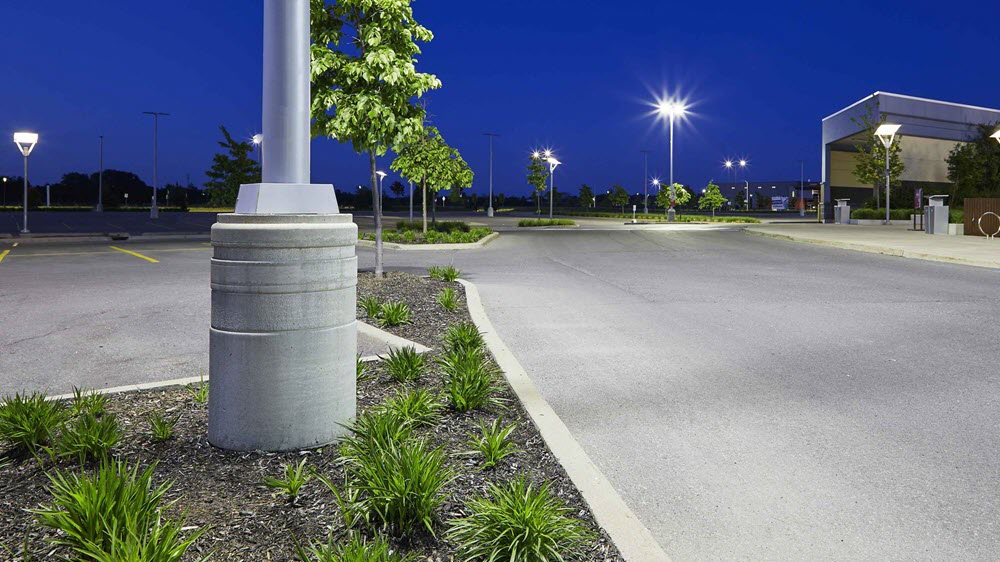Flood Light Base Servicesin Madison Heights MI
Comprehensive Flood Light Installation for Enhanced Safety
We Are Locally Owned & Operated For Over 37 Years
Contact Us Today!
We Serve Businesses In And Around The Following Cities:
About Flood Light Base Services
Flood Light Bases – Lighting Up Madison Heights Commercial Areas
Madison Heights, known for its flourishing commercial properties, has seen a considerable increase in the demand for suitable illumination solutions. Among these, one of the most vital is adequate flood lighting. It is not just the powerful beam of light that is essential, but equally critical is the component that supports the floodlight – the flood light base.
Understanding the prime role that floodlight bases play in the safety, aesthetics, and functionality of a commercial set-up can make all the difference. Let us unravel the significance of these crucial components, their applications, and how companies like D&J Contracting make the process seamless in the city of Madison Heights.
Understanding Flood Light Bases
Floodlight bases, also commonly known as flood light basins, form the foundation upon which a floodlight stands. They are designed to be sturdy and stable, taking on not just the weight of the equipment but also the environmental factors such as wind, rain, and snow. Weather resistance is key when it comes to these bases, confirming their continuous capability to support the floodlights in varying conditions.
The Process – Setting up a Reliable Flood Light Base
The groundwork for floodlight installation begins with choosing a suitable base. Factors such as the weight of the floodlight, weather conditions, terrain stability, and the desired positioning and height are taken into consideration. After deciding on the right base, an appropriate spot is marked for it. Once the ground is ready and the mounting brackets in place, the flood light bases are installed. This process may seem complicated, but professional construction companies in Madison Heights, such as D&J Contracting, have it down to an art – a carefully planned procedure ensuring a reliable floodlight setup.
Benefits of Proper Installation
A well-installed floodlight base provides multiple benefits. It imparts safety to the commercial property by ensuring the floodlights are secure, minimizes maintenance costs by ensuring longevity, and contributes significantly to aesthetic appeal. By lighting up the property efficiently, businesses can extend their working hours, giving them an edge over competitors. Moreover, effective lighting wards off criminal activities, providing a sense of security for workers and customers alike.
Real-world Applications in Madison Heights Commercial Areas
From the bustling Plaza 24 Shopping Center to the serene Red Oaks Nature Center, from the vibrant Madison Parks to the dynamic commercial outlets along John R Rd, Madison Heights showcases ample examples where floodlights play a crucial role. Across the city, construction experts like D&J Contracting are called upon to install sturdy flood light bases for numerous commercial establishments – enabling property owners to ensure safety and enhance visual appeal.
In a tech-driven world, it’s not uncommon for a warehouse to transition into a 24-hour operation hub or for a restaurant to extend its hours for a late-night service. With floodlight bases holding their own, floodlights in these situations prove invaluable, making progress seamless and safe.
Choosing the right contractor
While understanding the intricacies of flood light bases and their benefit is necessary, so is choosing the right contractor. Reliable companies such as D&J Contracting are adept at handling this complicated procedure. They ensure professional installation, minimizing the chances of issues cropping up in the future, serving as a value-added investment, providing long-term convenience and peace of mind.
Choosing the right floodlight setup can be a game-changer for your commercial property. By illuminating your surroundings efficiently, you can enhance safety, increase productivity, and at the same time, create a visually appealing environment. With skilled local contractors readily available to handle the technicalities, investing in high-quality flood light bases for your commercial properties in Madison Heights is a decision that will reap its rewards in time.
Flood Light Base Services Gallery


Call Us Today to receive your Free Quote for
Flood Light Bases in Madison Heights
Serving: Madison Heights, Michigan

About Madison Heights, Michigan
Originally part of Royal Oak Township, Madison Heights incorporated as a city by popular vote on January 17, 1955, and chartered on December 6 of that same year, becoming the tenth city government in southern Oakland County. At that time, the 7.2 square miles (18.6 km) city was one of the largest suburban communities in the Metro Detroit area. The first city hall was at 26305 John R Road, the former township offices. On April 5, 1963, a new municipal building was dedicated which is on the present location at 300 West Thirteen Mile Road. The city lies in the Interstate 696 (I-696) and I-75 corridor and is served by two primary school districts, Lamphere and Madison, as well as a full-service municipal government.
According to the United States Census Bureau, the city has a total area of 7.09 square miles (18.36 km), all land.
Although 91% of the buildings in Madison Heights are single-family homes or condominiums (approximately 9,800 residential property owners), 60% of the tax base is fueled by light industrial or commercial property. The city has 15 voting precincts, totaling more than 21,000 registered voters.
Madison Heights shares borders with Troy to the north, Royal Oak to the west, Hazel Park to the south, and Warren to the east. The eastern border of Madison Heights (Dequindre Road) is also the border between Oakland and Macomb counties.
There are more than 112 miles (180 km) of road within Madison Heights, of which the city maintains 105 miles (169 km), 95 miles (153 km) for snow removal, sweeping, and patching. Interstate 75 passes north to south on the west side of the city, and Interstate 696 is the major feature of its southern border. The junction of these two highways is shared with Royal Oak and Hazel Park on the southwest corner of Madison Heights.
| Census | Pop. | Note | %± |
|---|---|---|---|
| 1960 | 33,343 | — | |
| 1970 | 38,599 | 15.8% | |
| 1980 | 35,375 | −8.4% | |
| 1990 | 31,296 | −11.5% | |
| 2000 | 31,101 | −0.6% | |
| 2010 | 29,694 | −4.5% | |
| 2020 | 28,468 | −4.1% | |
| U.S. Decennial Census | |||
As of the 2020 United States census of 2020, there were 28,468 people and 13,487 households in the city. The population per square mile is 4,017.5.
The racial makeup of the city was 80.4% White, 7.8% African American, 0.2% Native American, 7.2% Asian, 0.1% Pacific Islander, 3.6% from two or more races. Hispanic or Latino residents of any race were 2.0% of the population.
There were 13,487 households, of which 14.7% spoke a language other than English at home. People under 65 years of age with a disability accounted for 11.1% of the city’s population, and 11.7% of the city’s population was living below the federal poverty line. Households without a broadband internet subscriptions made up 11.9% of the community.
16% of residents were under the age of 18; and 16.3% were 65 years of age or older. The gender makeup of the city was 49.4% male and 50.6% female.
As of the census of 2010, there were 29,694 people, 12,712 households, and 7,543 families residing in the city. The population density was 4,188.2 inhabitants per square mile (1,617.1/km). There were 13,685 housing units at an average density of 1,930.2 per square mile (745.3/km). The racial makeup of the city was 83.9% White, 6.4% African American, 0.5% Native American, 5.8% Asian, 0.1% Pacific Islander, 0.7% from other races, and 2.7% from two or more races. Hispanic or Latino residents of any race were 2.5% of the population.
There were 12,712 households, of which 27.5% had children under the age of 18 living with them, 41.0% were married couples living together, 12.9% had a female householder with no husband present, 5.4% had a male householder with no wife present, and 40.7% were non-families. 34.1% of all households were made up of individuals, and 11.8% had someone living alone who was 65 years of age or older. The average household size was 2.32 and the average family size was 3.02.
The median age in the city was 38.3 years. 20.4% of residents were under the age of 18; 8.7% were between the ages of 18 and 24; 30.4% were from 25 to 44; 26.6% were from 45 to 64; and 13.9% were 65 years of age or older. The gender makeup of the city was 49.1% male and 50.9% female.
As of the 2000 United States census, there were 31,101 people, 13,299 households, and 8,005 families residing in the city. The population density was 4,341.3 inhabitants per square mile (1,676.2/km). There were 13,623 housing units at an average density of 1,901.6 per square mile (734.2/km). The city’s racial makeup was 89.60% White, 1.82% African American, 0.44% Native American, 4.97% Asian, 0.03% Pacific Islander, 0.46% from other races, and 2.68% from two or more races. Hispanic or Latino residents of any race were 1.61% of the population.
There were 13,299 households, of which 26.9% had children under the age of 18 living with them, 45.2% were married couples living together, 10.5% had a female householder with no husband present, and 39.8% were non-families. 33.8% of all households were made up of individuals, and 12.3% had someone living alone who was 65 years of age or older. The average household size was 2.33 and the average family size was 3.02.
In the city, 22.1% of the population was under the age of 18, 8.1% was from 18 to 24, 35.4% from 25 to 44, 20.2% from 45 to 64, and 14.2% was 65 years of age or older. The median age was 36 years. For every 100 females, there were 95.8 males. For every 100 females age 18 and over, there were 92.9 males.
The city’s median household income was $42,326, and the median family income was $51,364. Males had a median income of $41,478 versus $29,345 for females. The city’s per capita income was $21,429. About 7.0% of families and 8.9% of the population were below the poverty line, including 10.8% of those under age 18 and 13.0% of those age 65 or over.
In 2008, 1.9% of the Madison Heights population were of Vietnamese descent. 168 Asian Mart, a 38,000-square-foot (3,500 m) supermarket, is the largest Asian supermarket in southeast Michigan, and one of the largest in the state. The Chinese Cultural Center is in Madison Heights.
The mayor of Madison Heights is Roslyn Grafstein, who was appointed as Mayor in August 2020 to fill a vacant seat.
Madison District Public Schools and Lamphere Public Schools have public schools serving Madison Heights.
Bishop Foley Catholic High School is a private school.
Four Corners Montessori Academy is a public charter school.
Call Us Today to receive your Free Quote for
Flood Light Bases in Madison Heights
Related Services in Madison Heights, Michigan
We Serve Businesses In The Following Zip Codes:
48007, 48015, 48021, 48026, 48035, 48036, 48038, 48042, 48043, 48044, 48045, 48046, 48047, 48048, 48050, 48051, 48066, 48071, 48080, 48081, 48082, 48083, 48084, 48085, 48088, 48089, 48090, 48091, 48092, 48093, 48098, 48099, 48225, 48230, 48236, 48310, 48311, 48312, 48313, 48314, 48315, 48316, 48317, 48318, 48397